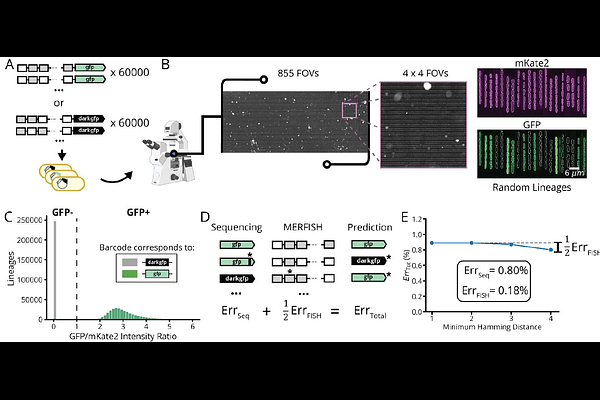Essentialome-Wide Multigenerational Imaging Reveals Mechanistic Origins of Cell Growth Laws

Essentialome-Wide Multigenerational Imaging Reveals Mechanistic Origins of Cell Growth Laws
Eaton, D. S.; Sanchez, C.; Gutierrez-Lopez, L.; Shenker, J. Q.; Goulev, Y.; Watson, B. R.; Henriot, V.; Garner, E. C.; Justman, Q. A.; Moffitt, J. R.; Paulsson, J.
AbstractOptical Pooled Screening (OPS) enables precise measurement of pooled genetic libraries in single, highly multiplexed microscopy experiments, linking image-based phenotypes to genotypes at genome-scale. However, no method has combined large-scale OPS with multi-generational time-lapse imaging, which is especially important for studying single-cell dynamics and physiology in microbes. Here we develop MARLIN, a technique for multigenerational time-lapse OPS in a microfluidic device and leverage it to map live-cell imaging data to genetic perturbations in a ~130,000-strain mismatch-CRISPRi library targeting all essential genes in E. coli. The resulting dataset comprises nearly a hundred million cell cycles and 1.6 billion cells, representing an average of 33 different knockdowns per gene, and provides quantitative measures of morphology and growth for each essential gene with respect to dose. We clustered our multidimensional time-lapse phenotypes to reveal exceptional correlations across co-functional genes, allowing us to systematically discover roles for essential genes of unknown function, as well as implicate RNase E as required for replication initiation. Further, we assayed dose-dependent correlations between growth and cell size for single genes, demonstrating shared regulation of size with ribosome synthesis, while also identifying limitations in existing growth control models. We reconcile these models with our data by positing SpoT as a sensor of translation elongation, which we validate through several lines of genetic and biochemical evidence. Finally, we show that a simple proteome-allocation model - where (p)ppGpp-control only passively limits division protein synthesis - explains all our size-growth scaling behaviors while also quantitatively linking cell size to ribosome abundance. Looking forward, we anticipate that MARLIN will be an essential tool for high-throughput genotype to phenotype mapping in microbes.